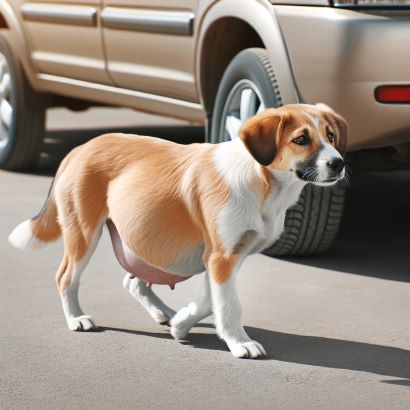when can a dog get pregnant? Understanding the dog Reproductive Cycle

The question of ”when can a dog get pregnant?” is crucial for a variety of reasons, ranging from responsible pet ownership to academic interest. This article aims to address the diverse intentions of readers who might be dog owners, breeders, veterinary students, or simply individuals curious about dog biology.
when can a dog get pregnant is centered around the concept of the canine estrous cycle. Unlike humans, who can become pregnant any time they are ovulating, dogs have specific times when they can conceive, known as being “in heat” or “in season”.
Understanding Dog Estrous Cycle
The diagram above illustrates the different stages of the canine estrous cycle, which includes:
- Proestrus: This phase marks the beginning of the heat cycle. Lasting approximately 9 days, it is characterized by the female dog attracting males, but not yet being receptive to mating. Physical signs include swelling of the vulva and a bloody vaginal discharge.
- Estrus: This is the period when the female dog is receptive to mating and ovulation occurs. Typically lasting 9 days, but it can vary from 3 to 21 days. The discharge seen during this phase is lighter in color and less in quantity compared to proestrus.
- Diestrus: Following estrus, the diestrus stage signifies the end of the dog’s fertile period. If the dog is pregnant, this phase lasts until the birth of the puppies (about 60-63 days). If not pregnant, it typically lasts around 60 days.
- Anestrus: The final stage is a period of sexual and hormonal inactivity between heat cycles. This phase lasts about 4 to 5 months, during which the dog’s body prepares for the next cycle.
When is a Dog Most Likely to Get Pregnant?

A dog is most likely to get pregnant during the estrus phase of its estrous cycle. This stage is commonly known as the dog being “in heat.” During estrus, several key factors align, making it the optimal time for conception:
- Ovulation: Estrus is the period when ovulation occurs. This is when the dog’s ovaries release eggs for fertilization.
- Receptiveness to Mating: Unlike the earlier proestrus phase, where the dog may attract males but is not yet receptive to mating, during estrus, the female dog is receptive to male dogs. This behavioral change is a clear indicator that the dog is at the peak of its fertility.
- Physical and Hormonal Changes: The estrus phase is also marked by physical and hormonal changes that support the possibility of pregnancy. The vaginal discharge, which is noticeable during proestrus, becomes lighter in color and less in quantity. These changes are driven by a complex interplay of hormones like estrogen and progesterone, which prepare the dog’s body for potential pregnancy.
The duration of estrus can vary from dog to dog, typically lasting around 9 days, but it can range from 3 to 21 days. The exact timing of ovulation within this window can also vary, so breeders often use a combination of physical signs, behavioral cues, and sometimes hormonal testing to pinpoint the most fertile days.
Read Also: german doodle: Introduction and Breed Overview
This table now provides a broader comparison of the estrus cycle across a variety of dog breeds.
| Breed | Estrus Cycle Duration (Days) | Common Symptoms |
|---|---|---|
| Labrador Retriever | 9-11 | Swelling of vulva, increased affection, tail flagging |
| German Shepherd | 10-12 | Vaginal discharge, frequent urination, male attraction |
| Beagle | 9-10 | Restlessness, swollen vulva, changes in appetite |
| Bulldog | 8-10 | Vulvar swelling, behavioral changes, nesting |
| Poodle | 10-12 | Attracting males, changes in behavior, lighter discharge |
| Siberian Husky | 9-12 | Behavioral changes, vulvar swelling, male attraction |
| Golden Retriever | 10-12 | Increased affection, lighter discharge, vulvar swelling |
| Boxer | 9-11 | Swollen vulva, increased urination, restlessness |
| Dachshund | 9-10 | Tail flagging, vulvar swelling, behavioral changes |
| Rottweiler | 10-12 | Male attraction, vulvar swelling, change in appetite |
| Pomeranian | 9-11 | Attracting males, changes in behavior, vulvar swelling |
| Shih Tzu | 9-10 | Restlessness, swollen vulva, changes in behavior |
| Chihuahua | 8-10 | Vulvar swelling, frequent urination, male attraction |
| Border Collie | 9-12 | Increased activity, swollen vulva, behavioral changes |
| French Bulldog | 9-10 | Restlessness, vulvar swelling, attracting males |
It’s important to note that not every mating during estrus results in pregnancy, and factors like the health of the dogs, timing, and frequency of mating can influence the outcome. For dog owners or breeders looking to avoid or achieve pregnancy in their dogs, understanding this cycle and consulting with a veterinarian for guidance is crucial.
Read Also: How Long Are Dogs Pregnant For?
Preventing Unwanted Pregnancy
Preventing unwanted pregnancies in dogs is a critical aspect of responsiblity for pet owners. It not only helps in managing the pet population but also contributes to the health and wellbeing of the dogs. Here are some key methods and considerations for preventing unwanted dog pregnancies:
- Spaying: Spaying (ovariohysterectomy) is the surgical removal of a female dog’s ovaries and usually the uterus. This procedure eliminates the possibility of pregnancy and also stops the estrous cycle, meaning the dog will no longer go into heat. Spaying has additional health benefits, such as reducing the risk of certain cancers and uterine infections like pyometra.
- Neutering Male Dogs: Neutering (castration) involves the surgical removal of a male dog’s testicles. This procedure not only prevents the male from impregnating females but also can reduce certain unwanted behaviors and health risks, such as prostate problems and certain types of cancers.
- Responsible Management: For those who choose not to spay or neuter their dogs, responsible management is crucial. This includes closely monitoring and controlling the dog’s environment to prevent access to unneutered males (for female dogs) or unspayed females (for male dogs), especially during the female’s estrus cycle.
- Education and Awareness: Educating dog owners about the canine reproductive cycle, the responsibilities of pet ownership, and the risks of unplanned litters is vital. Understanding the signs of heat in females and the behavior of males around females in heat can help in better management.
- Barrier Methods: While less common and not as reliable as spaying and neutering, some pet owners may use physical barriers or protective clothing for female dogs during their heat cycle to prevent mating.
- Chemical Sterilization: In some cases, chemical sterilization can be used as an alternative to surgical neutering in males. However, this method has varying levels of effectiveness and acceptance, and its availability and legality can vary by region.
- Adoption and Rescue Awareness: Promoting the adoption of dogs from shelters and rescues can help reduce the number of unwanted litters. Encouraging pet adoption over purchasing can help control the pet population and reduce the demand for breeding.
- Legislation and Community Programs: Some regions have legislation in place requiring the spaying and neutering of pets. Additionally, community programs offering low-cost spaying and neutering can help reduce the number of unwanted litters, especially in under-served communities.
Preventing unwanted pregnancies in dogs is a multifaceted approach that requires the cooperation of dog owners, veterinarians, and the community. It’s not only about controlling the pet population but also ensuring the health and quality of life for the dogs themselves.

what age can a dog get pregnant?
Dogs can become pregnant during their first estrus cycle, which typically occurs between 6 and 12 months of age, but this can vary widely between breeds and individual dogs. Smaller breeds often reach sexual maturity earlier than larger breeds. Here’s an outline of the general age at which different dog breeds can first become pregnant:
- Small Breeds (e.g., Chihuahua, Pomeranian, Shih Tzu): These breeds may experience their first heat as early as 4-6 months of age.
- Medium Breeds (e.g., Beagle, Bulldog): Medium-sized breeds typically have their first estrus cycle between 6-9 months.
- Large Breeds (e.g., Labrador Retriever, German Shepherd): Larger dog breeds may not have their first heat until they are 9-12 months old or even later.
- Giant Breeds (e.g., Great Dane, Mastiff): In giant dog breeds, the first heat can be delayed until they are 12-18 months old.
It’s important to note that while a dog can become pregnant during her first heat cycle, it’s often advised not to breed a dog during this cycle. Breeding a dog too early can pose health risks for both the mother and the puppies, as the dog is still growing and may not be physically or mentally ready for the demands of pregnancy and motherhood.
Early signs of pregnancy in Different Breeds of dogs
Early signs of pregnancy in dogs can vary between breeds due to their distinct physical and behavioral characteristics. However, there are some common signs that are generally observed across different breeds:
- Labrador Retriever:
- Mild lethargy and reduced activity
- Slight increase in weight or abdominal swelling
- German Shepherd:
- Changes in eating habits, either increased or decreased appetite
- Nesting behavior, such as preparing a quiet space
- Beagle:
- Less playful and decreased activity levels
- Slight swelling of the abdomen
- Bulldog:
- Noticeable changes in behavior, possibly more clingy or aloof
- Increase in appetite
- Poodle:
- Increased nesting behavior, preparing for the arrival of puppies
- Becoming more affectionate and seeking more attention
- Siberian Husky:
- Slight weight gain, particularly in the abdominal area
- Behavioral changes, such as mood swings
- Golden Retriever:
- Lethargy or seeming more tired than usual
- Changes in appetite, either increased or decreased
- Boxer:
- Abdominal enlargement as the puppies grow
- Behavioral changes, including mood swings
- Dachshund:
- Appetite changes, which might include eating more or less
- Slight weight gain and abdominal enlargement
- Rottweiler:
- More pronounced nesting behavior
- May become more protective or clingy
- Pomeranian:
- Mild lethargy, less active than usual
- Changes in eating habits
- Shih Tzu:
- Increased affection towards the owner
- Slight increase in weight
- Chihuahua:
- Behavioral changes, including nesting behavior
- Possible appetite changes
- Border Collie:
- Increase in appetite
- Mild lethargy or less enthusiasm for physical activities
- French Bulldog:
- Abdominal swelling as the pregnancy progresses
- Changes in behavior, possibly seeking more comfort or being aloof
These signs are general and can vary from one individual to another. If pregnancy is suspected in a dog, a veterinarian’s confirmation and guidance are essential for proper prenatal care.
Read Also: Understanding the Yorkie-Pitbull Mix: A Comprehensive Guide
Conclusion
Understanding when can a dog get pregnant is important for a range of reasons. Whether you are a dog owner, breeder, veterinary professional, or simply someone interested in canine biology, having this knowledge is key to responsible dog care and management. It’s always recommended to consult with a veterinarian for personalized advice and information.
Read Also: The Top 10 Reasons to get a Dog into Your Life
faq
How long after bleeding is a dog fertile?
A dog is fertile approximately 9-10 days after bleeding starts, during the estrus phase when ovulation occurs.
When can a dog get pregnant during heat?
A dog can get pregnant during the estrus phase of the heat cycle, which typically begins after the initial bleeding phase.
At what age can a dog impregnate a female?
Male dogs can impregnate a female once they reach sexual maturity, which can be as early as six months old for some breeds.
Can a dog get pregnant when not in heat?
A dog cannot get pregnant when not in heat, as ovulation and the fertile phase are part of the heat cycle.
How long does a female dog bleed before she’s ready to breed?
A female dog typically bleeds for the first 7-10 days of the heat cycle, but is ready to breed during the subsequent estrus phase.
Can a female dog get pregnant while bleeding?
Yes, a female dog can get pregnant while she is still bleeding if she has entered the estrus phase of her cycle early.
how often do dogs get periods?
Dogs go into heat, which is comparable to a period in humans, about every six months, although this can vary by breed and individual dog.





